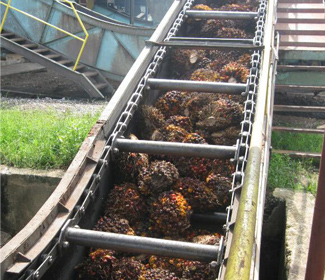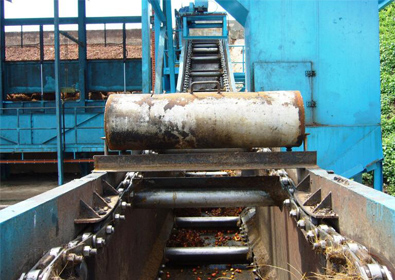GIDI CHAIN LIMITED supply various of large pitch conveyor chains. Conveyor chain is mainly applied in conveyor equipment or conveyor system. It help conveyor system to transport kinds of material.
Conveyor chains are used in
Mining
Food processing
Sewage treatment
Timber harvesting
Agriculture
Textile machinery
Car plants
Cement works
Material handling

Short/Double Pitch Conveyor Chains
1. BS/DIN Standard Short Pitch Attachment Chains: 08B-24B
2. BS/DIN Standard Double Pitch Conveyor Chains:C208B-C224BL
3. ANSI Standard Short Pitch Attachment Roller Chains:40-160
4. ANSI Double Pitch conveyor Attachment Chains: 2040-2120
5. ANSI Double Pitch Conveyor Roller Chains: C2040-C2162H
6. ANSI Double Pitch Conveyor Attachment Chains: C2040-C2122H
7. BS/DIN and ANSI Short Pitch Hollow Pin Chains: 08BHP-12BHP,40HP-80HP
8. ANSI Double Pitch Hollow Pin Chains: C2040HP-C2080HP,C2042HP-C2082HP
9. ISO/BS/DIN Large Pitch Hollow Pin Chains:MC,BS,FVT Series
10. Made-to-Order Hollow Pin Chains: 260 & 262
11. Side Bow Chains (Special Curved Chains): 08BSB-10BSB,35SB-80SB
12. Free Flow Conveyor Chains: Double plus chain,Triple speed chain and Accumulator chain
13. Side Roller Conveyor Chains: 40PST-100PST,C2040PSR-C2100HPSR
14. Top Roller Conveyor Chains: 40TR-100TR,C2040TR-C2100TR
Large Pitch Conveyor Chains (Long Pitch Engineering Class Conveyor Chains)
1. ISO Standard Solid Pin Conveyor Chains (ISO 1977): M,MT
2. ISO Standard Hollow Pin Conveyor Chains (ISO 1977): MC,MCT
3. BS Standard Metric Series Solid Pin Conveyor Chains (BS 4116): E,ET
4. BS Standard Metric Series Hollow Pin Conveyor Chains (BS 4116):EC,ECT
5. BS Standard Imperial Series Solid Pin Conveyor Chains (BS 4116): Z,ZT
6. BS Standard Imperial Series Hollow Pin Conveyor Chains (BS 4116): ZC,ZCT
7. DIN Standard Conveyor Chains (DIN 8167 and DIN 8168): FV,FVH,FVT
8. ANSI Standard Plain Conveyor Chain (ANSI B29.15): 0703-2430
9. Standard Bucket Elevator Chains: DT150-DT250
10. Bearing Bush Conveyor Chains
11. Bearing Roller Conveyor Chains
Conveyor chains, are widely used for conveyor system. The most important feature for the conveyor chain is large and heavy. We are a professional conveyor chain manufacturer. And especially in large pitch conveyor chain,we have high technology to satisfy customers’ demand.
What Is A Conveyor Chain?
A conveyor chain is a type of chain which is used in the conveyor system. It moves materials from one place to another by means of rollers and plates connected by chains. The pitch of a conveyor chain varies depending on the product being transported.
Lighter chains use Polyethylene tracks for wear resistance and lower power requirements, while heavier chains use special hardened alloy steel tracks with a higher load-carrying capacity and long life.
A conveyor chain is often used to move materials in industrial settings, and it can be a very reliable, cost-effective solution for certain applications. The main advantages of this type of chain are its low maintenance, high tensile strength, and ease of assembly. Many different applications require different kinds of conveyor chains, so it is important to find the one that best suits your needs.
The pitch of a conveyor chain is a measurement of how fast a sprocket rotates. The smaller the pitch, the faster the chain can rotate, but the larger the articulating angle, the higher the rotational speed.
The smaller the pitch, the more chain links are engaged during motion. A lower articulating angle, in contrast, produces less vibration and a smoother motion. There are several international standards for conveyor chains, but the British Standard is the most common.
How Does a Conveyor Chain Work?
A conveyor chain is made up of a series of journal bearings that link together. The bearings contain a brush and pin, which helps the chain roller to move. The forces generated by the journal bearings must not be excessive since this can cause the belt to break. Additionally, the chain must be free of a torsion component. This can lead to transversal oscillations or speeds that are not optimum.
The main purpose of a conveyor system is feeding and conveying. The former involves moving materials from pickup points to drop points. The latter, on the other hand, involves delivering the product continuously or in batches.
The working mechanism of a conveyor chain includes the pulley system, which is an external component. The belt moves on the frame and needs to be supported to move smoothly. The pulley system has two rotors on each unit, while more complex systems have more.
The chain is supported by a drive wheel that rotates in a circular motion. The drive wheel exerts a force on the chain. The force is applied by friction and the load itself. A set of idler wheels supports the chain, which may be smooth or toothed, and rests on plates or rollers. The slack strand supports the chain.
The chains are bearings that are connected together by constraining link plates. It contains a brush and pin on which the chain roller revolves. When the power is on, the motor will rotate, and the chain will move. As the chain moves, it will move the material on the top as well. This is how a conveyor chain works to move material from one place to another.
What Is Conveyor Chain Used For?
A conveyor chain is a metal chain with pins and bushes connected to each other. The chain can be used to convey a wide variety of goods from one place to another. There are different types of chains.
Some are designed for light materials, while others are designed for heavy materials. For industrial applications, the chain is often long and has a large number of links. The length and pitch of a chain vary according to the purpose of the chain.
There are many types of conveyor chains, each with its own advantages and disadvantages. For example, two-strand chains are best suited for transporting lightweight containers, such as PET bottles.
They also have an advantage over flat-top chains, which are better for handling most types of containers. Unlike flat-top chains, these conveyors are not only capable of elevating but also conveying products.
The conveyor chain is widely used in various industries. Here are some of the common things a conveyor chain is used for.
Mining
During the industrial revolution, mining facilities began using conveyors for moving bulk materials. As the technology advanced, the technology was further developed and now comes in many different materials. While today’s conveyors use a variety of different materials, the original concept of the conveyor chain has been in use for centuries. In mining, a conveyor chain is used to transport all types of materials from ore to crushed ore.
Food Processing
When you talk about a conveyor chain, it’s hard not to think of food. From rollers to belts to dumpers, food is moved around with ease. It doesn’t matter if it is processed, raw materials, or organics. It all needs to be moved in a safe, efficient way. In order to process as well as packaged food items, a conveyor chain is used.
Sewage Treatment
A conveyor chain is a vital part of the sewage treatment process, and a good quality one will last for a long time. Waste treatment facilities are becoming more prevalent, thanks to public concerns about the environment. A conveyor chain is essential for these processes, but traditional chains can wear quickly. These chains help to easily treat sewage and water. Most of the machines in sewage treatment plants work on a conveyor chain.
Timber Harvesting
A conveyor chain is a common tool used in timber harvesting. Depending on the type of wood, chains can be designed to move large volumes of timber quickly. These types of chains are also popular in agriculture and the harvesting of fruits and vegetables. These types of chains have a variety of uses and can be purchased separately.
Agriculture
A conveyor chain is a popular material handling equipment used in agricultural applications. Its wide variety of uses is suited to various industries and equipment. Hay, for example, is the most commonly baled crop. Different types of balers are designed to produce different kinds of bales. For the splicing process, the individual links are put together using simple tools.
Textile Machinery
The conveyor chain is a key component in the textile machinery industry. This material is widely used in the textile industry and is available in several varieties. The BS standard is the most common and is designed to meet the needs of the British marketplace. The ISO standard is the most commonly used in Europe and the US.
Car Plants
Conveyor chains are used in many processes in automobile production. From the raw materials to the finished product, chains are a common part of most conveyor systems. These systems require the movement of large amounts of material, and the failure of a conveyor chain could disrupt a large portion of a production line.
Cement Works
A cement work requires a chain conveyor to move bulk materials between various stages of production. Typically, these chains use a single strand and can be manufactured to a variety of standards. In the United Kingdom, British Standard chains are used.
Material Handling
A chain conveyor is a type of belt system that moves heavy or large loads. It is a common material handling solution in industries such as agriculture and automotive manufacturing, where it can be used to help with paint application and other processes.